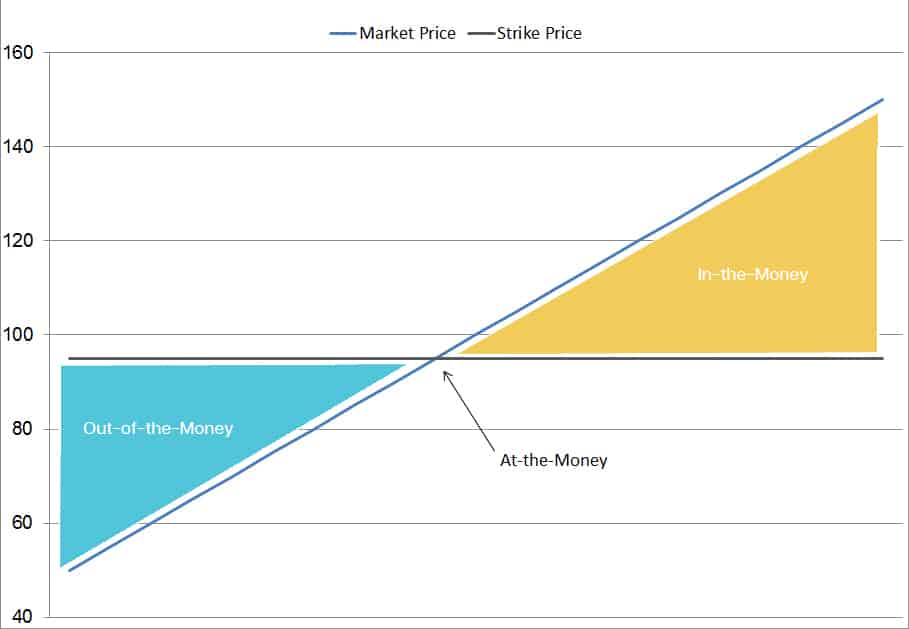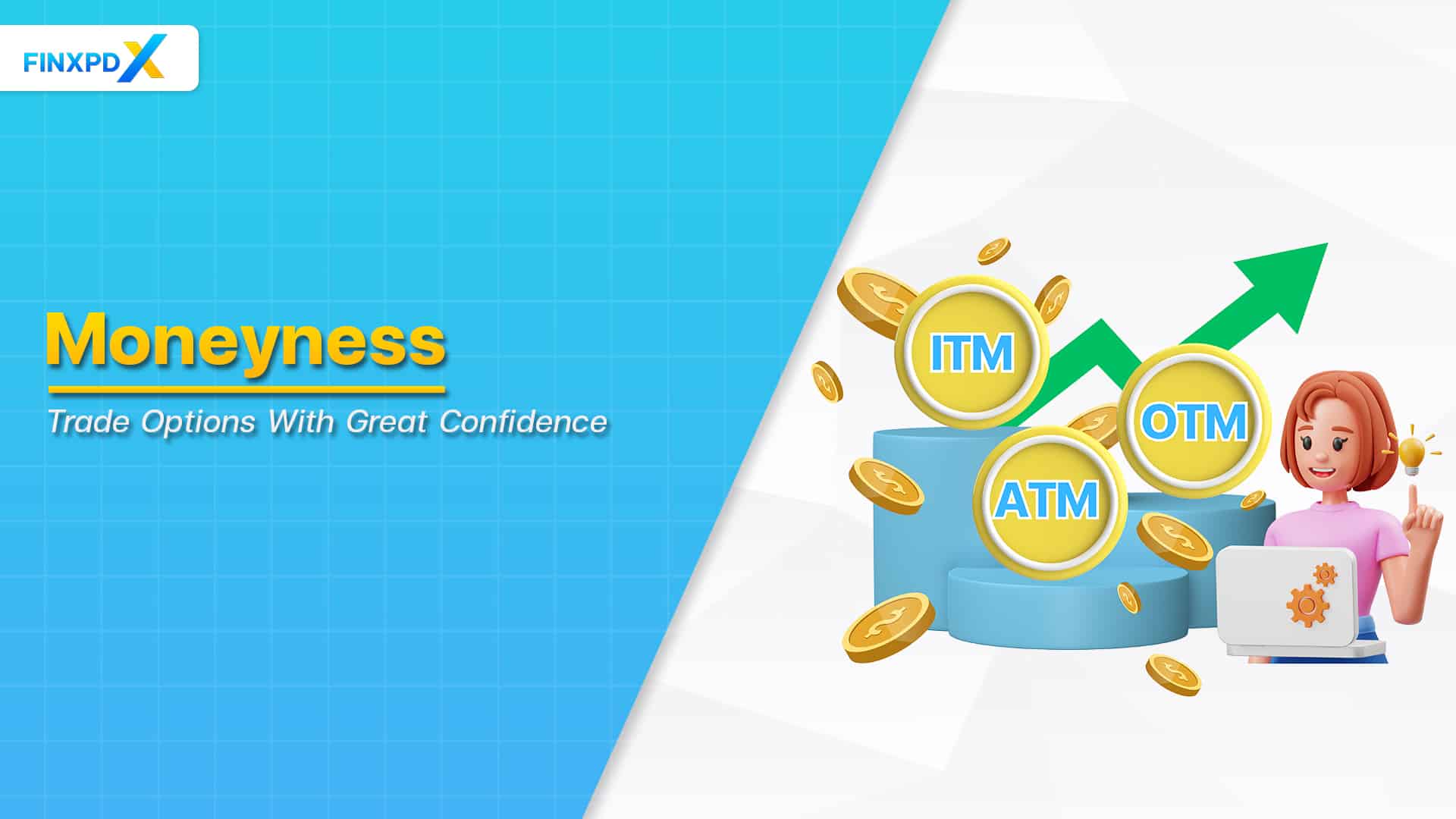Understanding the concept of moneyness is essential for anyone looking to navigate the options market with confidence. It can be beneficial to understand an option’s intrinsic value as well as to determine a particular schedule for trading.
This article aims to provide the basis of each moneyness category, its significance, and how traders may utilize this information. It also briefly introduces the concept of intrinsic value and time value of options to enhance trading strategies.
What Is Moneyness?
Moneyness is a key concept in the world of finance, especially within the options trading domain. It describes the relationship between an underlying asset’s current market price and an option’s strike price. Understanding moneyness is essential for traders and investors, as it helps them evaluate options’ intrinsic value and potential profitability. This concept divides options into three main categories: In the Money (ITM), At the Money (ATM), and Out of the Money (OTM), each indicating different levels of profitability and risk.
Key Takeaways
- Moneyness determines an option’s current status concerning the strike price and the underlying asset’s market price.
- Intrinsic value measures an option’s immediate operation value, reflecting the difference between the asset’s market and strike prices.
- The time value of options represents the premium paid over the intrinsic value, reflecting the potential for further gains.
- Moneyness and delta have different roles in the world of options trading. Moneyness determines an option’s potential profitability, while delta measures its value’s expected variation for a one-point price change in the underlying asset.
Types of Moneyness

The option moneyness is divided into 3 types, providing insights into option valuation and strategic positioning. This part provides investors with the knowledge they need to make smart trading decisions:
1. In the Money (ITM)
- Definition: An option is considered in the money when it possesses intrinsic value. For a call option, this means the current price of the underlying asset is above the strike price. For a put option, it means the current price is below the strike price.
- Characteristics: ITM options are more expensive because of their intrinsic value but offer a higher probability of profit if held to expiration.
2. At the Money (ATM)
- Definition: An option is at the money when the current price of the underlying asset is equal to or very close to the strike price.
- Characteristics: ATM options have no intrinsic value and are cheaper than ITM options. They are sensitive to changes in the market price of the underlying asset.
3. Out of the Money (OTM)
- Definition: An option is out of the money when it lacks intrinsic value. For a call option, this means the current price of the underlying asset is below the strike price. For a put option, the current price is above the strike price.
- Characteristics: OTM options are less expensive than ITM and ATM options. However, they are also considered riskier because they require the underlying asset to move significantly in the desired direction to become profitable.
The Concept of Intrinsic Value and Time Value of Options
Recognizing these concepts of intrinsic and time value assists traders and investors in understanding the options market, increasing returns, and avoiding losses through comprehension of an option’s total price, or premium.
Intrinsic Value
The intrinsic value of an option reflects the actual value if the option were exercised at the current time. It’s determined by the relationship between the option’s strike price and the underlying asset’s current price. For call options, the intrinsic value is the amount by which the current price of the underlying asset exceeds the strike price. For put options, it’s the amount by which the strike price exceeds the underlying asset’s current price.
Time Value
The time value of an option represents the additional amount that traders are willing to pay over the intrinsic value, based on the probability that the option will increase in value before expiration. The time value is influenced by various factors, including:
1. Time to Expiration
Options with longer durations before expiration typically have higher time values, as there’s more time for the underlying asset to move in a favorable direction.
2. Volatility
Higher volatility in the underlying asset’s price increases the option’s chance of becoming profitable, thereby increasing its time value.
3. Interest Rates
Higher interest rates can increase the time value of call options, as the cost of carrying positions in the underlying asset increases.
⚠️Tip: There are two components to the value of an option: the time value and the intrinsic value. They provide “option value” by combining them all.
The Significance of Understanding Moneyness
Understanding moneyness, a core concept in options trading and financial markets, is not just a measure of profitability but a strategic tool influencing decision-making, risk management, and the potential return on investment. Here is the significance of understanding money and how it impacts various aspects of trading and investment strategies.
1. The Impact of Moneyness on Trading Strategies
The moneyness of an option significantly impacts the trading strategy an investor might choose. ITM options are often less risky but more expensive, making them suitable for investors with a conservative outlook or those seeking to hedge their positions. ATM and OTM options are cheaper and offer higher leverage, attracting traders looking for higher returns at a greater risk. The choice between these options depends on the trader’s market outlook, risk tolerance, and investment objectives.
2. Moneyness and Risk Management
Understanding option moneyness is also crucial for effective risk management in trading strategies. It allows traders to evaluate the potential risk and reward of different options, guiding them in constructing a diversified portfolio that aligns with their risk tolerance. By carefully selecting options based on their moneyness, traders can manage their exposure to market volatility and protect against potential losses.
The Difference Between Moneyness and Delta
Moneyness and delta are important terms in finance, especially in options trading. Both serve various goals and give traders and investors different kinds of information. Understanding the difference between moneyness and delta is essential for anyone to effectively make money in the options market.
1. Nature of Measurement
Moneyness is a qualitative measure that categorizes options based on their intrinsic value and the relationship between the strike price and the underlying asset’s current price. Delta is a quantitative measure that expresses the sensitivity of an option’s price to a unit change in the underlying asset’s price.
2. Function and Use
Moneyness helps traders understand an option’s intrinsic value and its position relative to the underlying asset’s price. Delta provides a deeper insight into the option’s price behavior, its sensitivity to price changes in the underlying asset, and the probability of finishing ITM.
3. Dynamic vs. Static
While moneyness and delta are affected by changes in the underlying asset’s price, delta also considers other factors like volatility, time to expiration, and interest rates, making it a more dynamic measure that can offer predictions about future price movements.
Conclusion
In conclusion, in the options market, moneyness plays a critical role in guiding investment returns, risk management, and strategic decision-making by providing data on the profitability of options. Understanding the feature between intrinsic and time values assists traders in making well-informed decisions. Knowing the distinctions between ITM (In the Money), ATM (At the Money), and OTM (Out of the Money) options helps them adapt strategies to their risk tolerance and confidently handle the complexities of the options market. The long-term worth of these principles guarantees that traders and investors are prepared to take advantage of opportunities and reduce risks as this market changes.
FAQs
Moneyness describes the position of an option’s strike price relative to the current market price of the underlying asset, indicating whether an option is in the money, at the money, or out of the money.
No, intrinsic value quantifies an option’s profit if exercised at the moment, focusing on the asset’s actual value, whereas moneyness indicates the option’s potential profitability position.
There are three main types: “In the Money” (options with intrinsic value), “At the Money” (options whose strike price is equal to the asset’s price), and “Out of the Money” (options without intrinsic value).
Moneyness isn’t calculated through a singular formula but is determined by comparing the option’s strike price with the underlying asset’s current market price to classify it as in the money, at the money, or out of the money.
No, moneyness and delta are not the same. Moneyness categorizes an option’s profitability potential, while delta estimates how much an option’s price would increase or decrease with a one-unit change in the underlying asset’s price.
Related Articles:
- Option Selling Guide: Boost Your Investment Portfolio
- Option Chain: Learn the Key Factors for Successful Trade
- Trading Loss: How to Approach Market Downturns
Read more: Stocks








